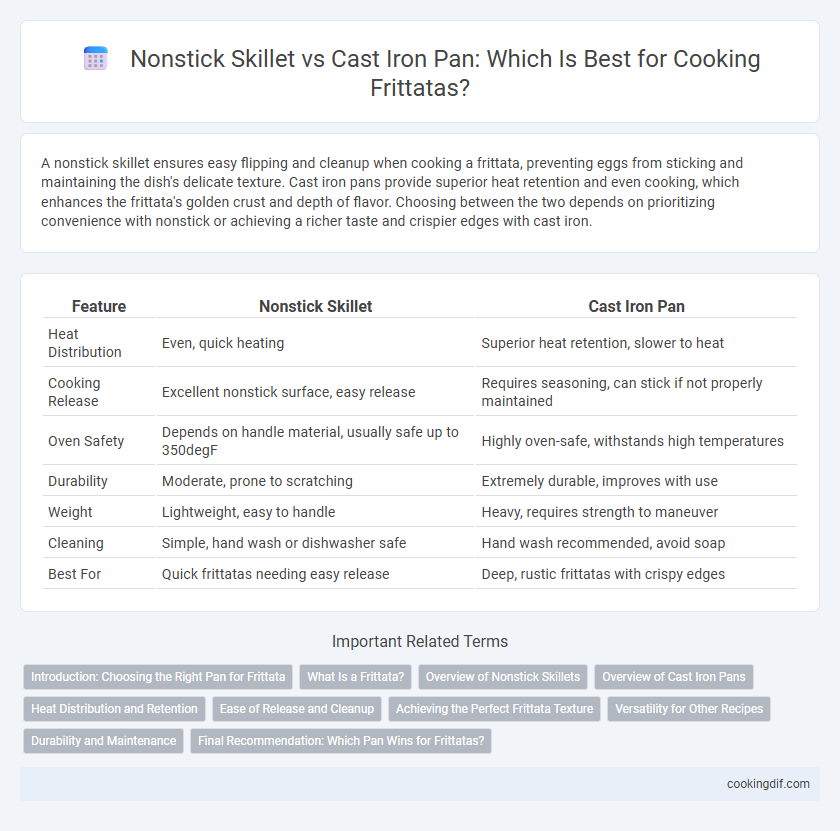A nonstick skillet ensures easy flipping and cleanup when cooking a frittata, preventing eggs from sticking and maintaining the dish's delicate texture. Cast iron pans provide superior heat retention and even cooking, which enhances the frittata's golden crust and depth of flavor. Choosing between the two depends on prioritizing convenience with nonstick or achieving a richer taste and crispier edges with cast iron.
Table of Comparison
| Feature | Nonstick Skillet | Cast Iron Pan |
|---|---|---|
| Heat Distribution | Even, quick heating | Superior heat retention, slower to heat |
| Cooking Release | Excellent nonstick surface, easy release | Requires seasoning, can stick if not properly maintained |
| Oven Safety | Depends on handle material, usually safe up to 350degF | Highly oven-safe, withstands high temperatures |
| Durability | Moderate, prone to scratching | Extremely durable, improves with use |
| Weight | Lightweight, easy to handle | Heavy, requires strength to maneuver |
| Cleaning | Simple, hand wash or dishwasher safe | Hand wash recommended, avoid soap |
| Best For | Quick frittatas needing easy release | Deep, rustic frittatas with crispy edges |
Introduction: Choosing the Right Pan for Frittata
A nonstick skillet offers easy release and simple cleanup, ideal for delicate frittatas and beginner cooks seeking convenience. Cast iron pans provide superior heat retention and even cooking, resulting in a perfectly browned crust and consistent texture. Selecting between these pans depends on desired cooking style, maintenance preference, and the importance of heat control for achieving the ideal frittata.
What Is a Frittata?
A frittata is an Italian-style omelet characterized by its thick, open-faced design filled with vegetables, cheese, and meats, cooked slowly to ensure even texture and rich flavor. Using a nonstick skillet for a frittata provides easy release and quicker cleanup, ideal for delicate eggs and preventing sticking during stovetop cooking and oven finishing. Cast iron pans offer superior heat retention and develop a natural nonstick surface over time, enhancing the frittata's crispy edges and evenly browned bottom for a more rustic and flavorful result.
Overview of Nonstick Skillets
Nonstick skillets offer an ideal surface for cooking frittatas due to their smooth coating that prevents sticking without excessive oil or butter. Their lightweight design and even heat distribution help achieve a uniform, tender texture while allowing easy flipping and serving. These pans are especially favorable for delicate eggs, minimizing the risk of burns and ensuring effortless cleanup compared to cast iron alternatives.
Overview of Cast Iron Pans
Cast iron pans offer superior heat retention and even cooking, essential for achieving a perfectly browned frittata crust. Their durability and natural nonstick seasoning improve with use, allowing for easy flipping and serving without sticking. However, cast iron requires proper maintenance to prevent rust and maintain its cooking performance over time.
Heat Distribution and Retention
Cast iron pans provide superior heat retention, maintaining consistent temperatures ideal for slow, even cooking of frittatas, while nonstick skillets offer quicker heat distribution for faster cooking but lose heat more rapidly. The dense construction of cast iron ensures the frittata cooks uniformly without hot spots, enhancing texture and preventing burning. Nonstick skillets, although convenient for cleanup and preventing sticking, may result in uneven cooking due to less efficient heat retention.
Ease of Release and Cleanup
Nonstick skillets provide superior ease of release for frittatas, preventing sticking and ensuring clean slices, while their smooth surface significantly simplifies cleanup by requiring minimal scrubbing. Cast iron pans offer excellent heat retention but demand thorough seasoning and careful maintenance to prevent sticking, often resulting in more challenging release and labor-intensive cleaning. Opting for nonstick skillets enhances convenience during both cooking and cleanup phases of frittata preparation.
Achieving the Perfect Frittata Texture
A nonstick skillet provides even heat distribution and easy release, ensuring a tender, custard-like frittata texture with minimal sticking. Cast iron pans deliver superior heat retention and develop a flavorful, crispy crust while maintaining a creamy interior. Choosing the right pan depends on whether you prefer a delicate softness or a rustic, browned finish in your frittata.
Versatility for Other Recipes
A nonstick skillet offers superior versatility for cooking delicate dishes like frittatas, as well as sauteing vegetables and making pancakes without sticking. Cast iron pans excel in heat retention, making them ideal for recipes requiring even cooking and a crispy crust, such as roasting and searing meats. Both pans are essential in a kitchen, with nonstick favored for ease of flipping and cleaning, while cast iron enhances flavor development across diverse culinary applications.
Durability and Maintenance
Cast iron pans offer superior durability due to their robust construction that withstands high heat and years of use without warping. While cast iron requires regular seasoning and careful drying to maintain its nonstick properties, nonstick skillets demand gentler cleaning and are prone to coating degradation over time. Choosing between the two involves weighing the long-term maintenance commitment of cast iron against the convenience but shorter lifespan of nonstick surfaces.
Final Recommendation: Which Pan Wins for Frittatas?
A nonstick skillet offers easy release and minimal oil use, making it ideal for delicate frittatas that require gentle cooking and flipping. Cast iron pans excel in even heat retention and develop a natural nonstick surface with seasoning, delivering a crispy crust and rich flavor. For the perfect frittata, choose a nonstick skillet for convenience and a cast iron pan for enhanced texture and depth of taste.
Nonstick skillet vs Cast iron pan for frittata cooking Infographic

 cookingdif.com
cookingdif.com